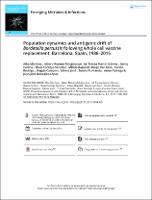Population dynamics and antigenic drift of Bordetella pertussis following whole cell vaccine replacement, Barcelona, Spain, 1986–2015
Author
Date
2019-11-26Permanent link
https://hdl.handle.net/11351/5859DOI
10.1080/22221751.2019.1694395
ISSN
2222-1751
WOS
000499252900001
PMID
31769735
Abstract
Among the factors associated with the resurgence of whooping cough, special emphasis has been given to pathogen adaptation after the introduction of the acellular vaccine (ACV). To assess the impact of the vaccine transition strategy from whole-cell vaccine (WCV) to ACV on population dynamics of Bordetella pertussis in Barcelona (Spain), we studied 339 isolates collected from 1986 to 2015 by PFGE and multi-locus variable-number tandem repeat analysis (MLVA). Additionally, allelic variants for the pertussis toxin and its promoter, pertactin, type 3 fimbriae and fimbrial serotyping were assessed to determine its antigenic drift. A shift was observed in the B. pertussis population as well as in its antigenic profile concurrently with the introduction of ACV in Barcelona. Four out of the five most prevalent PFGE profiles were replaced by new profiles following the ACV introduction. MLVA type 27 was the dominant genotype, and its frequency increased from 25% to 79.3% after WCV replacement. Antigen typing demonstrated the emergence of prn2, ptxP3, fim3-2 and a shift from the fimbriae 3 to the fimbriae 2 serotypes after the ACV introduction. Our findings support the presence of population and antigenic dynamic changes in B. pertussis likely driven by the introduction of ACV.
Keywords
MLVA; PFGE; Pertussis vaccineBibliographic citation
Mir-Cros A, Moreno-Mingorance A, Martín-Gómez MT, Codina G, Cornejo-Sánchez T, Rajadell M, et al. Population dynamics and antigenic drift of Bordetella pertussis following whole cell vaccine replacement, Barcelona, Spain, 1986–2015. Emerg Microbes Infect. 2019 Nov 26;8(1):1711–20.
Audience
Professionals
This item appears in following collections
- HVH - Articles científics [4476]
The following license files are associated with this item:

 Private area
Private area Contact Us
Contact Us








